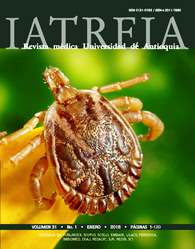Butyrylcholinesterase deficiency identified after succinylcholine administration. Case report
DOI:
https://doi.org/10.17533/udea.iatreia.v31n1a10Keywords:
butyrylcholinesterase, deficiency, succinylcholine, paralysisAbstract
The main function of the enzyme butyrylcholinesterase is to hydrolyze exogenous esters such as those present in the neuromuscular blocking agent succinylcholine, which is frequently used in short surgical procedures. Inheritance of atypical butyrylcholinesterase or butyrylcholinesterase deficiency is considered an autosomal recessive characteristic and occurs worldwide in approximately one out of 3200 to 5000 people. Such deficiency may have serious consequences for patients anesthetized with that relaxant because sometimes it causes an extension of paralysis or postoperative apnea. We report the case of a 73-year-old woman submitted to subtotal thyroidectomy. After surgery, she did not spontaneously emerge from anesthesia, had signs of relaxation with poor inspiratory effort, and no recovery of neuromuscular response. After application of atropine, reversal was attempted with neostigmine, but it failed, and she was transferred to the ICU. Laboratory results revealed a reduced level of serum cholinesterase indicating a deficiency in butyrylcholinesterase consistent with her symptoms. Such situation has been described in medical literature.
Downloads
References
(1.) Soliday FK, Conley YP, Henker R. Pseudocholinesterase deficiency: a comprehensive review of genetic, acquired, and drug influences. AANA J. 2010 Aug;78(4):313-20.
(2.) Bhargava D, Sharma J, Al-Abri R. Plasma pseudo cholinesterase deficiency leading to seven hour apnoea in a child undergoing adeno-tonsillectomy. Int J Pediatr Otorhinolaryngol. 2012 Jan;76(1):149-51. DOI 10.1016/j.ijporl.2011.10.010.
(3.) Wecksell M, Koutsospyros D. Pseudocholinesterase deficiency in a octogenarian undergoing total intravenous anesthesia; implications for neuromonitoring. Middle East J Anaesthesiol. 2015 Jun;23(2):157-62.
(4.) Lurati AR. Organophosphate exposure with pseudocholinesterase deficiency. Workplace Health Saf. 2013 Jun;61(6):243-5. DOI 10.3928/21650799-20130529-78.
(5.) Lee S, Han JW, Kim ES. Butyrylcholinesterase deficiency identified by preoperative patient interview. Korean J Anesthesiol. 2013 Dec;65(6 Suppl):S1-3. DOI 10.4097/kjae.2013.65.6S.S1.
(6.) Cassel J, Staehr-Rye AK, Nielsen CV, Gätke MR. Use of neuromuscular monitoring to detect prolonged effect of succinylcholine or mivacurium: three case reports. Acta Anaesthesiol Scand. 2014 Sep;58(8):1040-3. DOI 10.1111/aas.12357.
(7.) Whittington JE, Pham HD, Procter M, Grenache DG, Mao R. A patient with prolonged paralysis. Clin Chem. 2012 Mar;58(3):496-500. DOI 10.1373/clinchem.2011.163782.
(8.) Leadingham CL. A case of pseudocholinesterase deficiency in the PACU. J Perianesth Nurs. 2007 Aug;22(4):265-71; quiz 272-4. DOI 10.1016/j.jopan.2007.05.005.
(9.) Kaufman SE, Donnell RW, Aiken DC, Magee C. Prolonged neuromuscular paralysis following rapidsequence intubation with succinylcholine. Ann Pharmacother. 2011 Apr;45(4):e21. DOI 10.1345/aph.1P753.
(10.) Delacour H, Lushchekina S, Mabboux I, Ceppa F, Masson P, Schopfer LM, et al. Characterization of a novel butyrylcholinesterase point mutation (p.Ala34Val), “silent” with mivacurium. Biochem Pharmacol. 2014 Dec;92(3):476-83. DOI 10.1016/j.bcp.2014.09.014.
(11.) Delacour H, Lushchekina S, Mabboux I, Bousquet A, Ceppa F, Schopfer LM, et al. Characterization of a novel BCHE “silent” allele: point mutation (p.Val204Asp) causes loss of activity and prolonged apnea with suxamethonium. PLoS One. 2014 Jul;9(7):e101552. DOI 10.1371/journal.pone.0101552.
(12.) Fernández López E, Regueiro Unzaga SD, Pérez Giliberti JD, Rojas González C. Pseudocolinesterasas plasmáticas: a propósito de un caso. Mediciego [Internet]. 2012 [consultado 2017 Feb 21];18. Disponible en: http://bvs.sld.cu/revistas/mciego/vol_18noespc_2012/casos/t-47.html
(13.) Reti IM, Torres J, Morad A, Jayaram G. Pseudocholinesterase deficiency in an ECT patient: a case report. Psychosomatics. 2011 Jul-Aug;52(4):392-3. DOI 10.1016/j.psym.2011.01.029.
(14.) Sánchez LH, Medina OM, Gómez G, González CI, Flórez-Vargas Ó. Laboratory genetic-based reference values for cholinesterase activity in a Colombian population: A step forward in personalized diagnostics. Biomedica. 2015 Aug;35 Spec:20-9. DOI 10.1590/S0120-41572015000500003.
(15.) Brozović G, Mazul Sunko B, Hafner T, Bekavac I. Allergic reaction to suxamethonium during emergency caesarean section and pseudocholinesterase deficiency in the same patient. Wien Klin Wochenschr. 2014 Jul;126(13-14):435-8. DOI 10.1007/s00508-014-0561-1.
(16.) Jurkolow G, Fuchs-Buder T, Lemoine A, Raft J, Rocq N, Meistelman C. [Prolonged phase II neuromuscular blockade following succinylcholine administration]. Ann Fr Anesth Reanim. 2014 Mar;33(3):176-7. DOI 10.1016/j.annfar.2013.12.017. French.
(17.) Jaramillo KS, Scruth E, Cheng E. Prolonged paralysis and apnea after receiving a neuromuscular blocking agent: what nurses should know. Am J Crit Care. 2009 Nov;18(6):592, 588-91. DOI 10.4037/ajcc2009572.
Published
How to Cite
Issue
Section
License
Copyright (c) 2018 Universidad de Antioquia

This work is licensed under a Creative Commons Attribution-NonCommercial-ShareAlike 4.0 International License.
Papers published in the journal are available for use under the Creative Commons license, specifically Attribution-NonCommercial-ShareAlike 4.0 International.
The papers must be unpublished and sent exclusively to the Journal Iatreia; the author uploading the contribution is required to submit two fully completed formats: article submission and authorship responsibility.














